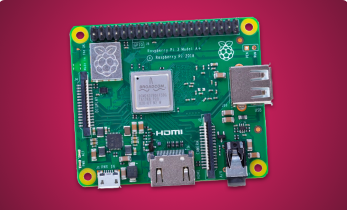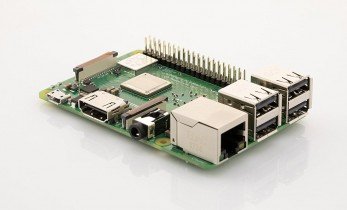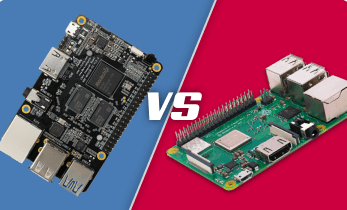Raspberry Pi 3 Model B+ released: Upgraded processor, faster networking
There’s no shortage of single-board computer (SBC) options available. From the Banana Pi to BeagleBoard, makers benefit from loads of SBCs for a variety of do-it-yourself (DIY) project bases. However, the Raspberry Pi remains a top choice. This derives from fantastic community support and a bevvy of operating system options for the Raspberry Pi, from Raspbian to Ubuntu and openSUSE. On March 14, 2018, fittingly Pi (3.14) day, the Raspberry Pi 3 Model B+ gets released. The new Pi board features faster networking, more performance power, and a slew of enhancements.
Raspberry Pi 3 Model B+
The latest iteration of the Raspberry Pi features a 1.4GHz 64-bit quad-core ARM Cortex-A53 CPU, although it’s the same processor, but with a new heatsink. As such, it’s boosted from 1.2GHz to 1.4GHz. On the networking front, you’ll find 802.11ac wireless LAN as well as Bluetooth 4.2. The Pi 3 Model B+ sees faster Ethernet with Gigabit Ethernet over USB 2.0. Furthermore, the Pi 3 Model B+ gains power-over-Ethernet support with the PoE HAT add-on. Thermal management is improved as well. For its peak CPU clock frequency, there’s a 200MHz jump for almost three times the wireless and wired throughput.
Specs (via RaspberryPi.org)
- Broadcom BCM2837B0, Cortex-A53 (ARMv8) 64-bit SoC @ 1.4GHz
- 1GB LPDDR2 SDRAM
- 2.4GHz and 5GHz IEEE 802.11.b/g/n/ac wireless LAN, Bluetooth 4.2, BLE
- Gigabit Ethernet over USB 2.0 (maximum throughput 300Mbps)
- Extended 40-pin GPIO header
- Full-size HDMI
- 4 USB 2.0 ports
- CSI camera port for connecting a Raspberry Pi camera
- DSI display port for connecting a Raspberry Pi touchscreen display
- 4-pole stereo output and composite video port
- Micro SD port for loading your operating system and storing data
- 5V/2.5A DC power input
- Power-over-Ethernet (PoE) support (requires separate PoE HAT)
Cost: $35
That’s a decent performance boost to computing power and networking. The Raspberry Pi 3 Model B+ comes two years after the launch of the Raspberry Pi 3 Model B. According to benchmarks, the Model B+ yields a Tx (transmission rate) bandwidth of 315Mb/s, and Rx (receive rate) bandwidth of 315Mb/s, compared to the Pi 3 Model B’s 94.1 and 95.5 respectively.
What’s really impressive is that the new Raspberry Pi 3 Model B+ clocks in at a mere $35, the same cost as its predecessor. With a performance boost, better networking, and the same price tag, the Raspberry Pi 3 Model B+ is absolutely worth buying, whether you’re new to the SBC space of already have a Pi board or two lying around.
Estefannie from Estefannie Explains it All ran a few tests including calculating Pi on the Pi 3 Model 3 B and B+ because naturally (while eating pie mind you). On this, the Model B+ completed over a minute faster. For its networking, file transfers completed several minutes quicker on the B+. Real-world testing, therefore, proves that the B+ delivers on its promises. It’s a faster board for both computing tests and networking applications.
It’s pleasing to see a refresh of the Raspberry Pi 3 Model B. Sure, there’s no new chip, but the latest iteration of the Pi 3 offers a networking and processing enhancement in a board which maintains the same form factor, and thus compatibility with existing Raspberry Pi accessories. Additionally, packing on the likes of power over Ethernet means increased connectivity options. Because core hardware is generally the same, the Pi 3 Model B+ doesn’t break compatibility with its current slate of software options.
Alongside the new Raspberry Pi 3 Model B+, you’ll find an update to Raspbian. The changelog reports that there’s Raspberry Pi 3 Model B+ support, enhanced Pi-top device support, Linux kernel 4.9.80+, and more. Check out the full changelog below:
- Raspberry Pi 3 B+ support
- WiFi is disabled until wireless regulatory domain is set (Pi 3 B+ only)
- The domain can be done through 'Raspberry Pi Configuration' (rc_gui),
- 'raspi-config' or by setting 'country=' to an appropriate ISO 3166
- alpha2 country code in /etc/wpa_supplicant/wpa_supplicant.conf.
- Default wireless regulatory domain is now unset
- Added support to desktop for different screen sizes and resolutions, including multiple preset options in Appearance Settings and pixel doubling option in Raspberry Pi Configuration
- Version 2.1.16 of Thonny included
- Version 29.0.0.113 of Adobe PepperFlash player included
- Version 1.2.post1 of Pygame Zero included
- Bluetooth plugin now supports connection to Bluetooth LE HID devices
- Network plugin now indicates 5G-compatible APs
- Latest changes to Bluez ALSA service merged
- Service now started on CLI boot as well as GUI boot
- Latest changes to dhcpcd networking plugin merged
- Improved support for running on pi-top devices
- Small design changes to PiX theme and icons
- Bug fix - hide spurious window resize handles
- Bug fix - Scratch 2 remote GPIO state block now works correctly
- Updated WiFi Firmware
- brcmfmac43455-sdio 7.45.154
- brcmfmac43430-sdio 7.45.98.38
- New packages:
- policykit-1
- obconf
- python-buttonshim python3-buttonshim
- python-unicornhathd python3-unicornhathd
- python-pantilthat python3-pantilthat
- Linux kernel 4.9.80+
- Raspberry Pi firmware 3347884c7df574bbabeff6dca63caf686e629699
Raspberry Pi 3 Model B+ debut: Final thoughts
The Raspberry Pi Foundation has done it again. Sure, the Raspberry Pi 3 Model B+ isn’t a major overhaul, but it delivers plenty of upgrades to posit the new board as a worthy upgrade. The only slight downside is that the new Pi consumes more power, though the 5V 2.5A Raspberry Pi power supply is still sufficient. I for one will definitely be snagging a Pi 3 Model B+ board and moving my RetroPie and Recalbox setup to that. Then, I’ll relegate my Pi 2 Board to a project such as a wall mounted dashboard or AI assistant with Mycroft Pi. Need a case for your new Pi 3 Model B+? Try one of these sweet cases.
Your turn: will you be getting a Raspberry Pi 3 Model B+?














































Leave your feedback...